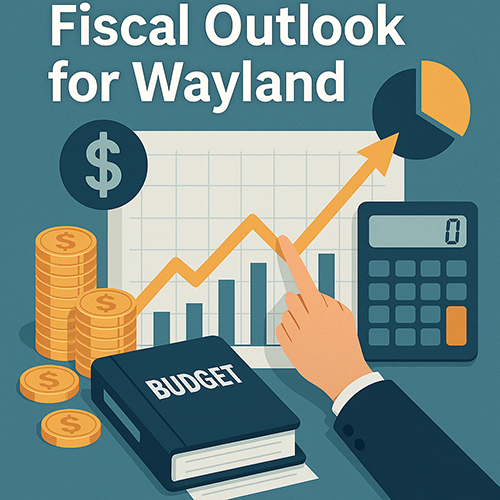At the November 2025 Financial Summit, Town Manager Michael McCall and Finance Director Brian Keveny presented a cautiously optimistic outlook for Wayland’s fiscal position heading into Fiscal 2027. While the town remains financially stable and maintains its AAA bond rating, rising costs across payroll, insurance, and school budgets signal continuing pressure on taxpayers within Proposition 2½ limits.
Fiscal 2025 Results and Free Cash Outlook
Unaudited results for Fiscal 2025 show a net surplus of roughly $1.46 million, primarily from departmental “turnbacks” and higher-than-expected local receipts. Local receipts exceeded budget by $1.36 million, while expenditures came in $2.36 million below budget. Free cash, estimated at $12.3 million (pending state certification), is among the highest in the town’s history.
The largest turnbacks came from public safety ($506,107), general government ($390,043), and health insurance savings ($336,303). These contributed to the town’s ability to replenish stabilization reserves and fund capital needs without immediate overrides.
FY2026 Tax Recap and FY2027 Forecast
The Fiscal 2026 tax recap projects a $121.9 million budget, up 5 percent from FY2025, with a 2.88 percent tax increase, lower than the 3.61 percent estimated at Annual Town Meeting. The average residential tax rate is expected to be $15.73 per $1,000 in valuation.
For FY2027, the town anticipates total available revenue of $116.36 million, with property taxes accounting for 79 percent. The remaining sources include state aid (8 percent), local receipts (6 percent), and free cash or transfers (3 percent). A structural gap of about $670,000 remains between forecasted expenses and available revenue.
Rising Costs Drive Expense Growth
The FY2027 forecast shows a total budget increase of 5.1 percent, or $5.49 million, driven by payroll adjustments and rising insurance costs. The school budget is projected to rise 5.5 percent to $58 million, while the town’s operating budget grows 3.2 percent to $24.9 million. Unclassified budgets, including pensions, health insurance, and energy, are projected to grow nearly 6 percent, with a 12 percent jump in insurance costs alone.
Health insurance is expected to remain a volatile factor, with final rates due in February 2026. No new full-time employees are proposed in FY2027 for either the schools or municipal departments.
Reserves and Long-Term Liabilities
Wayland continues to maintain healthy reserves. As of November 2025, balances include $33.5 million in Other Post-Employment Benefits (OPEB) for retiree health and disability insurances, and survivor benefits. $5.16 million in general stabilization, and an estimated $12 million in free cash.
However, long-term obligations remain significant. The Middlesex County Retirement System’s unfunded pension liability for Wayland stands at $58 million, with full funding targeted for 2036. The OPEB liability is $42.2 million, 44 percent funded, with full funding projected by 2047.
Moody’s Maintains Aaa Rating, Warns on Long-Term Ratios
In October, Moody’s Investors Service reaffirmed Wayland’s Aaa rating, citing a stable tax base and high resident income levels. However, analysts cautioned that sustained fund balances below 25 percent of revenues or large new debt issuances not excluded from Proposition 2½ could lead to a downgrade.
Using Moody’s updated methodology, Wayland’s fund balance ratio stands at 25 percent, up from 20 percent under the older measure, and just within the agency’s 25–40 percent guideline..
Development Pipeline Could Ease Future Pressures
The presentation outlined several permitted and proposed developments expected to influence new growth and future revenues. Permitted projects include the 60-unit Saint Ann affordable housing development at 124 Cochituate Road, the Terrain redevelopment of the former Whole Foods plaza, and a new Dunkin’ Donuts/Jimmy John’s at 289 Boston Post Road.
Potential projects still under discussion include the 212 Cochituate shared living proposal, multi-family housing at 50 Andrew Avenue and 526 Boston Post Road, and redevelopment of the Route 20 West corridor, including the former Mahoney’s site.
Perspective and Next Steps
Select Board member Carol Martin emphasized the need for early budget coordination to maintain services without triggering an override. Finance Committee member Phil Giudice noted that the town’s long-term sustainability will hinge on balancing labor contracts, school costs, and infrastructure debt.
Doug Levine inquired, “Can free cash not be used to plug any of this deficit we’re looking at each year? If we have $12 million in free cash and a $2 million deficit—why can’t we tap free cash?” Keveny responded “You can do that for one year. Moody’s wouldn’t ding us for a one-year fix… but it’s not sustainable. You don’t want to get in that habit.” Martin emphasized, “It’s kicking the can down the road.”
McCall said the administration’s priority is “preserving fiscal stability while supporting necessary investments in town and school operations.” The FY2027 budget process will proceed through early 2026, with final figures presented at the spring Annual Town Meeting.













